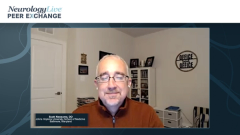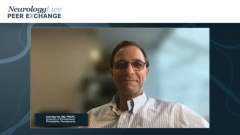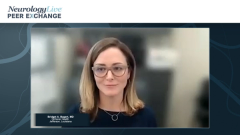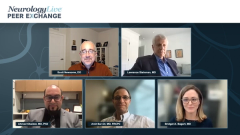
Novel and Emerging Targets in Multiple Sclerosis
Experts in neurology share their hopes for the future of multiple sclerosis treatment and discuss unmet needs and novel targets.
Episodes in this series

Scott Newsome, DO: I have another question because this has been fantastic. Let’s shift a little away from EBV [Epstein-Barr virus] and thinking about new targets for MS [multiple sclerosis]. I’ll set the stage by saying I’m very excited that we have emerging targets that target the innate immune system if we think about BTK [Bruton tyrosine kinase] inhibitors, for example. I want to hear from all of you. What’s exciting you with the emerging novel therapeutics? Where do should we be going? It’s a loaded question. We have colleagues who will say, “I want to look at metabolomics. Can we influence metabolomics? Can you influence the innate immune system? What about neuro repair?” What excites each of you? We can’t talk about EBV because we’re already excited about EBV. Bridget, do you want to kick us off?
Bridget A. Bagert, MD: No.
Scott Newsome, DO: No?
Bridget A. Bagert, MD: Honestly, I reject your question because the thing that truly excites me is EBV.
Scott Newsome, DO: That’s good. That’s fine.
Bridget A. Bagert, MD: EBV is where we should be focusing, but thinking about the other things isn’t mutually exclusive, because there’s every reason to believe that innate immunity in the brain has something to do with what Epstein-Barr virus does to the immune system and therefore to the brain. The BTKs are probably involved in ameliorating that. I don’t think they’re mutually exclusive. Those studies are definitely very exciting, and we’re participating in them.
Scott Newsome, DO: I love it. She rejected it. She said, “No, we’re talking about EBV,” which is fine. This is an open-ended question. To your point, BTK inhibitors, and their influence on B cells, are really an interesting, and evolving story. Sorry, I cut you off.
Bridget A. Bagert, MD: That’s it. That’s my answer.
Scott Newsome, DO: How about others? If you all want to say, “We’re sticking to EBV,” that’s OK.
Ahmed Obeidat, MD, PhD: Focusing on the central nervous system [CNS] targets within the brain, the spinal cord, is where we’re excited. This includes EBV targeting cells that are latently infected by the virus. Butin the future we’re also probably looking at combination therapy in MS. I like the idea of targeting neuroprotection, remyelination, viruses, and the immune system all at the same time, and perhaps, or maybe at different stages, 2 or 3 of them or maybe more. But combination therapy may have a role in MS treatment in the future. This is what I’m most excited about. I want to see more of those studies. I want to think about those studies in the future.
Scott Newsome, DO: I heard you give a very similar philosophy and outlook at CMSC [Consortium of Multiple Sclerosis Centers] when you were talking to junior folks, the workforce of the future. That’s awesome. I’m very similar in terms of the combination therapeutic approach, because that may be a good approach moving forward. What about you guys? Larry, Amit?
Lawrence Steinman, MD: Here’s my take on the innate immune system. Drew Weissman and Katalin Karikó found out how to turn off the innate immune system so that TLRs [toll-like receptors] don’t respond to RNA. Early in 2021, they figured out a way of further tweaking RNA vaccines. With Ugur Sahin and Özlem Türeci and Ari Waisman, they published a paper in Science showing that you could tolerize in that well using the EAE [experimental autoimmune encephalomyelitis] model to the known suspects at the time. I assume they have enough money; we don’t need to have a government handout to BioNTech. But they had to try to tolerize GlialCAM and anoctamin-2 with the tool they published in Science and see what happens. They’re going to do it.
Amit and I once upon a time were involved with the DNA approach to something like that. We were going to try that because there’s nothing crazier than competing with BioNTech when you’re a small lab. But it’s fun to be David vs Goliath. May both sides win the race. But that’s what I would try. It incorporates your question: what can we do about the innate immune system? Weissman and Karikó took care of that for us with the RNA vaccine so elegantly. A small additional tweak, which was a great invention, leads to a tolerizing vaccine rather than an immunizing vaccine.
Amit Bar-Or, MD, FRCPC: I was going to pick up on the theme of tolerizing vaccines, but since Larry has, I’ll extend what Ahmed was saying before as well. On 1 hand, combination therapy targets the great unmet need of progressive MS and particularly repair, which of course is not a problem that’s unique to multiple sclerosis. It remains a very big problem. Similar to Larry’s concept of tolerance, 1 thing I’d like to achieve—and it may be tractable over the next years—is how can you treat immunologically but not forever? How can you do something transiently and then establish durable quiescence of disease? That will be hugely important in terms of limiting the amount of exposure to a drug that may be safe over a few years, but it also won’t be as safe as the years go on, not to mention costs. Also, it cleans up the background, having therapies that might be targeting progressive disease or repair. I just did a review recently…on the next generation of CNS-targeting agents in MS. It’s challenging to find an agent that will act on a single pathway or network without also acting on others. In fact, it’s very difficult to find agents that work exclusively on what we might view as the neurobiology of the disease and not the immunology, or vice versa, for agents that get into the CNS. If you could take away a piece of what contributes to injury over time and then be left with the other biology, you may have a better opportunity to target it as well and not require combination therapy.
Scott Newsome, DO: There’s still a lot of work to do. I thought we were going to solve it with EBV, but I’m excited. I wasn’t such a believer in the EBV story until these recent papers came out. Thank you, Larry and Alberto Ascherio. These are incredible pieces of work and seminal papers. I want to thank the panel. You were awesome. I’d love to do this again. I learn a lot every time I do such an engagement. On behalf of our panelists, thank you for watching this NeurologyLive® Peer Exchange.
Transcript Edited for Clarity
Newsletter
Keep your finger on the pulse of neurology—subscribe to NeurologyLive for expert interviews, new data, and breakthrough treatment updates.









